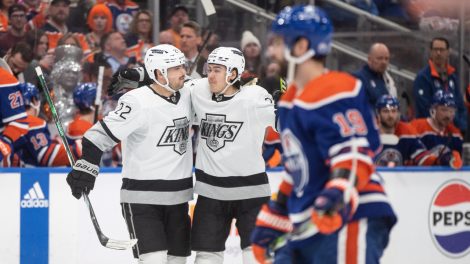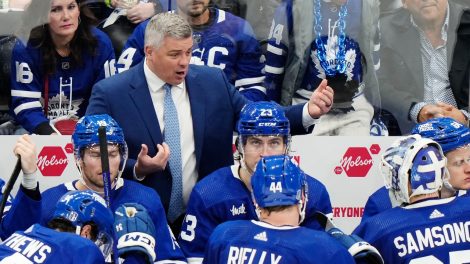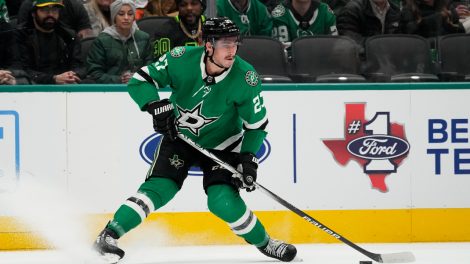‘Fix’ might be too strong a word.
When a power play like the one the Montreal Canadiens ran this past season operates at a historically low efficiency rate, there are too many things going wrong for it to be completely remedied over a single off-season. The Canadiens only scored on 31 of 234 power-play opportunities, and that has as much to do with only winning just over 50 per cent of their faceoffs while on the man-advantage as it does with any failed strategy they employed or any other aspect of it you’d like to dissect.
If we’re taking stock of the whole thing — and without running through videos and screenshots that would force Canadiens fans to relive the horror they watched over 82 games of the 2018-19 season — this team, which played so fast at 5-on-5, slowed things down to a crawl at 5-on-4.
It struggled its way up the ice on many occasions. When it didn’t bungle the zone entry, it failed miserably to make a first pass that would allow for control to be established. It displayed slim-to-no puck support in the areas penalty killers tend to suffocate (the half-walls and corners), and it was terribly predictable — with play running mostly through point shooters Shea Weber and Jeff Petry.
Was coaching an issue? Absolutely.
Was execution to blame? Unquestionably.
Were the Canadiens missing key pieces personnel-wise? Certainly.
So forgive us for suggesting there’s no viable way for all of this to be completely fixed come October. But, we do have some recommendations on how to improve it.
[relatedlinks]
1. Hand over duties to Dominique Ducharme
With respect to associate coach Kirk Muller, who helped the Canadiens run the second-best power play in the league from 2006-11 (before he left to become head coach of the American Hockey League’s Milwaukee Admirals), it’s time for Dominique Ducharme’s voice to be the main one heard when it comes to developing Montreal’s power-play strategy.
By no means are we suggesting the Canadiens fire Muller, who has one year remaining on his contract. But since he returned in 2016, the team has operated the 21st-best power play in the league, and that’s a big part of why it’s missed the Stanley Cup Playoffs in consecutive seasons.
As a head coach in the Quebec Major Junior Hockey League from 2011-18, Ducharme garnered an excellent reputation for his offensive strategies. He also ran a 22-per cent success rate on the power play if you average out how the Drummondville Voltigeurs (2016-18) and Halifax Mooseheads (2011-16) fared under his watch.
When we asked Jonathan Drouin in March to expand on what Ducharme has brought to the table since being hired as an assistant coach last spring, the Canadiens forward said his detail-oriented approach was one big thing.
“He picks up all these little things during a game, things most players wouldn’t focus on because they’re too wrapped up in the play,” said Drouin, who also played for Ducharme in Halifax from 2011-14. “He’s helped us a lot with his detailed approach and strategies.”
A more detailed approach can only help the power play.
2. Bring in a skills coach
The Columbus Blue Jackets, who struggled almost as badly as the Canadiens did from October to January on the power play, hired Hall of Famer Martin St. Louis as a special teams consultant on Jan. 21.
His job was to serve as a sounding board for the team’s power-play players, to help shape strategy, and to help refine skills before, during and after practice. His influence was tangible.
Before St. Louis joined the Blue Jackets, their power play scored 21 goals on 144 opportunities and ran at 14.5-per cent efficiency. After he joined, they scored on 13 of 79 opportunities (16.5 per cent) to close out the regular season, and then went 8-31 in the playoffs (25.8 per cent).
Only the Boston Bruins and Vegas Golden Knights were more dangerous with the man-advantage through the first two rounds of the post-season.
Surely there’s another former player out there — one with a similar pedigree to St. Louis’ and one who, like St. Louis, is barely five years removed from playing — who can help the Canadiens in like fashion.
3. Acquire a left-side defenceman
Earlier in the week, we had an elaborate piece on how the Canadiens can fill this gaping hole in their roster.
Of the players we brought up — and surely we missed one or two — Toronto Maple Leafs defenceman Jake Gardiner (pending unrestricted free agent) and Philadelphia Flyers defenceman Shayne Gostisbehere (potential trade target) are the ones that really pop out for the job of quarterbacking Montreal’s power play.
Gardiner has been a steady producer with the man-advantage throughout his career, notching 73 of his 245 points in those situations. He’s also an elite skater and a very capable puck-mover. The kind of player who can help the Canadiens break into the zone, help them get into rhythm, and help them score goals.
Gostisbehere, who has 21 power-play goals and 92 power-play points in 298 NHL games, is all of that and more. His booming shot adds another dimension, forcing teams to play him as tight as they would on Weber, and if those two are out there together it opens up other options on the ice.
4. Find a solution for the right half-wall
The Canadiens have to find a right-handed player to do the same job Drouin does on the power play, but from the right side of the ice.
We’re talking about a player like San Jose Sharks forward Kevin Labanc (not that we’re suggesting Labanc is available). A player who can freeze penalty killers by being a triple threat; a player with a lethal shot and equal passing and stickhandling ability, one who therefore keeps the opposition guessing at all times.
All season long, the Canadiens were missing that type of player on the right side of their power play, and it hurt them. We’re not discounting what righties Andrew Shaw and Brendan Gallagher bring to the table, nor what left-shooting Jesperi Kotkaniemi could do from the right side, but none of those players qualify as the type we’re referring to.
Who does is Nick Suzuki, a cerebral scorer who does things like this from the right side of the ice:
Completely forgot the Suzuki goal vid …… Here you go #GUEvsOTT pic.twitter.com/bZiZpydP2p
— – Guelph Storm (@Storm_City) May 9, 2019
We believe Suzuki has a good chance of making the Canadiens out of training camp and being a difference-maker for them. If that proves to be true, his biggest impact could very well be on the power play.
Still, the Canadiens aren’t going to bank on that. They’re likely inclined to scour the unrestricted free agent market for a reliable top-nine forward who can fill this gap. And if they land a player who fills this quotient and Suzuki manages to also make the team, the power play will benefit that much more.
Looking purely at right-handed shooters who might be available, Artemi Panarin (Columbus), Joe Pavelski (San Jose) and Jordan Eberle (New York Islanders) top the list.
Other players free to explore the market if their teams don’t renew their contract: Jason Pominville (Buffalo Sabres), Joonas Donskoi (San Jose), Brett Connolly (Washington Capitals), and Jason Spezza (Dallas Stars).
If the Canadiens can convince any one of them to sign, it could mark the biggest improvement for their power play.









